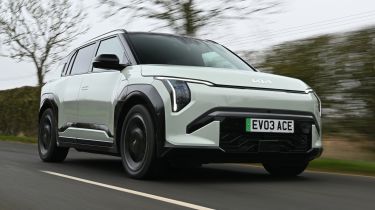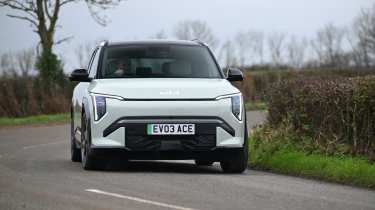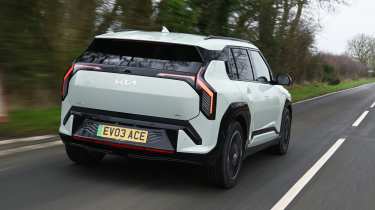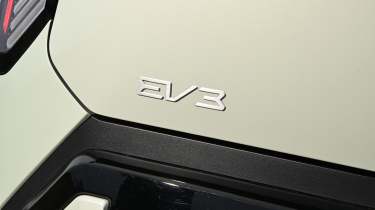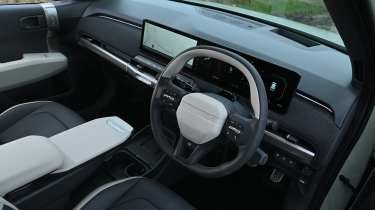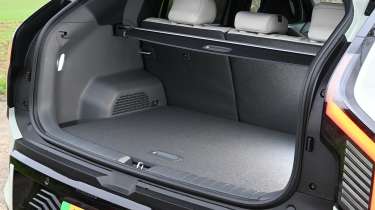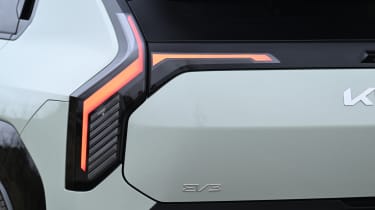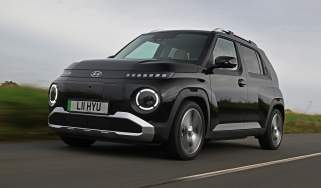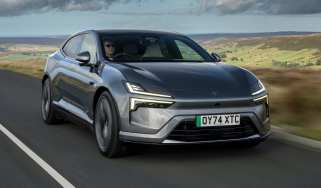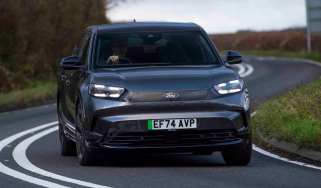Kia EV3 review
The Kia EV3 is a funky, comfortable and practical model that drives well and can travel a long way on charges
Pros
- Distinctive styling
- Spacious interior
- Efficient
Cons
- Not that engaging to drive
- Limited model range
- Heat pump is a costly extra
Kia EV3 verdict
Kia is quickly establishing itself as a leader when it comes to designing, engineering and selling electric cars. Its space-age seven-seat EV9 electric SUV shows the company can push the boundaries and be a rival to premium brands. But the Korean firm hasn’t forgotten what it does best – and that’s offering well designed and packaged EVs at a reasonable price. The EV3 is proof of this because it offers an excellent electric range for the money, it’s easy and comfortable to drive, it has all the technology you could want, and there’s loads of space inside – not to mention it looks rather funky, too.
Details, specs and alternatives
If you want to know how far electric cars have come in a decade, then take a look at Kia. Its Soul EV quietly arrived on the scene in 2015 with a small driving range and a high price tag, and naturally was overshadowed by its petrol equivalent. But now, 10 years on, Kia has a raft of battery-powered models, with some of them putting its petrol-car line-up in the shade.
Actually, the Soul EV is an interesting car to dwell on for a moment longer because the last version of that car was only ever available with an electric powertrain – and in effect the EV3 replaces it. Truth be told, the EV3 actually puts a huge question mark over the similarly sized Niro. But, because that model comes in hybrid and electric versions, Kia says it will still appeal to fleets. Well, for the time being anyway.
Of course, in Kia’s ‘EV’-branded electric line-up, the EV3 sits towards the lower end of a full range of planned models. There will be smaller ones and larger ones, with models like the EV3 taking some of the design themes already seen in the range-topping EV9. The EV3 is an electric family hatchback to rival cars like the Volkswagen ID.3, while its slightly lofty ride height and chunky body cladding mean it also rubs shoulders with compact electric SUVs such as the Volvo EX30, Skoda Elroq, and the Kona Electric from sister firm Hyundai.
Kia offers two batteries in the EV3 – 58.3kWh and 81.4kWh – which is more than most of its rivals. On paper, these larger batteries help to liberate a larger range, with Kia claiming up to 372 miles on a full charge from the larger pack. No matter which battery you go for, though, you get the same 201bhp electric motor.
The trim range comprises Air, GT-Line and GT-Line S. Entry-level Air with the 58.3kWh battery is priced at £32,995 and gets a pair of 12.3-inch screens, 17-inch alloys, heated front seats and steering wheel, front and rear parking sensors, a reversing camera, and a suite of safety equipment including blind spot collision avoidance assist. Upgrading to the larger 81.4kWh pack costs an extra £3,000.
From here onwards, only the larger pack is available. GT-Line, at £39,495, gets sportier styling, 19-inch alloys, artificial leather seats, a wireless phone charger, a digital key and fancier LED headlights. GT-Line S, for £42,995, adds a sunroof, a powered tailgate, ventilated front seats, heated rear seats, a head-up display, a Harman Kardon stereo system, and 'premium relaxation' front seats with memory (essentially one-touch recline). Disappointingly, a heat pump is a £900 option and is only available on the top-spec GT-Line S.
Range, battery size & charging
| Range | Wallbox charge time | Rapid charge |
|
58.3kWh 267 miles 81.4kWh 372 miles |
8hrs 45mins (0-100%, 7.4kW) 12hrs 30mins |
35mins (10-80%, 102kW) 36 mins (10-80%, 128kW) |
The EV3 sits on the same underpinnings as the much larger EV6 and EV9, but is front-wheel drive as opposed to rear-driven – presumably to prioritise boot space (although dual-motor versions could arrive in the future) – and swaps those cars’ nifty 800-volt charging tech for a 400-volt set-up. Consequently rapid charging isn’t quite as, well, rapid, with a 20-to-80-per-cent top-up taking around 35 minutes. DC charging is limited to 102kW for the standard-range EV3 and 128kW for the big-batteried version.
Speaking of batteries, Kia has opted for larger ones compared with most of the competition – 58.3kWh and 81.4kWh gross (55 and 78kW usable) – and the claimed ranges are 267 miles and 372 miles respectively. In warm conditions, we found that the large-battery EV3 could pretty much match the quoted figure of 370-ish miles. However, in damper, colder weather in Britain we found 3.3 miles/kWh was more likely, which equates to just under 260 miles on a full charge.
It’s a shame that only the top-spec EV3 GT-Line S can be ordered with a heat pump – and even then it is a £900 option. Vehicle-to-load (V2L) is standard across the range, however, which allows you to run any normal electrical device from the EV3’s three-pin socket – that’s really neat.
Running costs & insurance
While Kia may claim 267 and 372 miles is possible from the 58.3kWh and 81.4kWh batteries respectively, as always what range you actually get is entirely dependent on your driving style and the weather conditions. But we would expect anywhere between 180 and 220 miles for the small-battery car, and 250 to 320 for the larger one – that's pretty good considering the EV3's price.
A full charge from a home wallbox on a standard electricity tariff should cost between £15 and £20 (and likely considerably cheaper on a specific EV tariff), while a 10-80-per-cent charge from a rapid charger (75p/kW average) should be around £47 for the larger-battery car.
The EV3 falls into insurance group 32E for the small battery Air model, while selecting the larger battery bumps this up to 34E; the GT-Line is in 35E and the GT-Line S is placed in band 36E. Just as with all of its other models, Kia slaps a seven-year/100,000-mile warranty on the EV3; there's an eight-year warranty on the battery, and service intervals are 24 months/20,000 miles.
Performance, motor & drive
| 0-62mph | Top speed | Driven wheels | Power |
|
58.3kWh 7.5s 81.4kWh 7.7-7.9s |
105mph 105mph |
Front Front |
201bhp 201bhp |
While there's a difference in battery packs, for now there's just one choice of power – a 201bhp electric motor that drives the front wheels. Other electric hatchbacks such as the Cupra Born offer different power outputs; Volvo will even sell you a 422bhp version of the EX30 that can crack 0-62mph in 3.6 seconds.
Don't expect that kind of performance with the EV3, because 0-62mph takes between seven-and-a-half and eight seconds for all versions. That sounds pretty lethargic, but this is a family car after all, and in our tests the EV3 feels quick enough for normal everyday driving. The power delivery is certainly geared to be punchier at lower speeds, making the EV3 feel every bit as fast as its rivals around town. Only at higher speeds when overtaking slower vehicles on motorways do you feel the EV3's slight performance disadvantage.
It's an easy car to drive, is the EV3. There's great forward visibility and it's simple to get a comfortable driving position. In fact, comfortable is the name of the game here because the EV3 just shrugs off bumps and lumps in the road. The steering has a nice weighting to it, plus the paddles attached to the back of it control three levels of brake regeneration. The system is well calibrated and allows light regeneration right up to full one-pedal operation, the latter being really useful around town.
Interior, dashboard & infotainment
The shrunken EV9 vibes conținue on the inside, because the EV3’s dashboard has a similar look to its larger sibling’s. It's dominated by a pair of 12.3-inch screens and a smaller 5.3-inch display, which, unsurprisingly, are pinched from the EV3's big seven-seat sister. This is great because they are crisp, easy to read and, importantly, a doddle to use on the move. Beneath the infotainment screen there's a row of short-cut functions, and we love the physical scroll wheel for the volume, plus having buttons for the air-conditioning controls.
The entry-level Air has soft fabric seats which look and feel great, but there's an abundance of hard plastics on the doors. The posher GT-Line cars add softer materials around the interior, but even with the Air's harder fixtures and fittings, you can't say it's a cheap-feeling interior – it all feels robust.
Boot space, seating & practicality
| Length | Width | Height | Boot space (seats up/down) |
| 4,300mm-4,310mm | 1,850mm | 1,560mm | 460/1,251 litres |
It feels roomy up front and there are several useful cubbies – the centre armrest is pretty nifty because it can turn into a mini table, while underneath this there’s a large storage area. This feeling continues into the rear where a couple of six-footers will have plenty of space, mostly thanks to the EV3's boxy shape liberating good headroom.
Boot space comes to 460 litres when the seats are up, which is more than in the Volkswagen ID.3 and Volvo EX30, and slightly ahead of the Renault Megane E-Tech. Fold the seats down and the EV3's is about the same as the ID.3 and EX30, but slightly behind the Megane. However, unlike a Smart #1, the rear seats don't slide backwards and forwards, which might put some potential buyers off if they need a more flexible interior. There is some under-the-bonnet – or ’frunk’ – storage with the EV3, but it's tiny; you could use it to store your charging cable, but you'll have to be hugely patient packing it.
Reliability & safety rating
Independent safety body Euro NCAP hasn't tested the EV3 yet. But given that even the entry-level Air packs a whole raft of safety gizmos as standard, it's fair to say the EV3 will be a safe car.
In terms of reliability, time and time again Kia has scored highly in our Driver Power customer satisfaction survey. It finished in third place in 2024, for example, so expectations are high that the EV3 will continue this strong performance.
